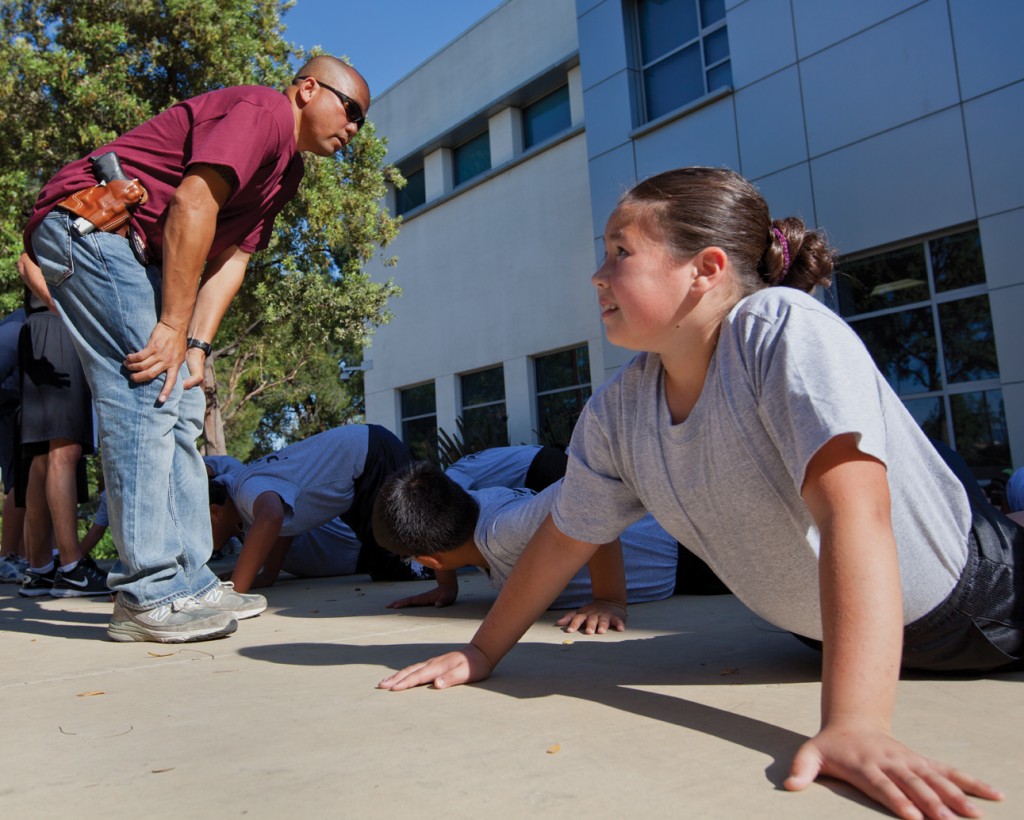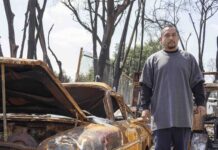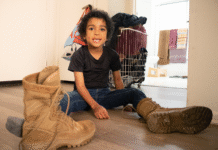Story by Michaia Hernandez
Photos by Joe Kukuczka
LAPD officers focus on the youth of a community through programs
It is an unusual sight, even for a police station. Around 30 children form five rows; their arms lay flat against their sides, their heads face forward, and their postures are rigid. Behind the group, two boys no older than 12 are doing push-ups.
“One, sir. Two, sir. Three, sir,” they chant in unison to nobody in particular.
At the front of the group, West Valley Officer Edison Vistar watches the group like a hawk, managing to ensure that the two boys are carrying out the consequences of their disobedience and that the rest of the kids aren’t disrupting the formation.
“I’m always consistent as far as discipline goes with the kids, and they respect that,” he says.
Edison helps oversee Junior Police, a new program sponsored by the West Valley branch of the Los Angeles Police Department (LAPD) that emulates cadet training for children ages 10 to 14. The program is in its early stages, having started earlier this year.
Edison, who has been in law enforcement for eight years, is also one of the pioneers of Junior Police.
Parents would inquire about something similar to the cadet program for their kids, one that teaches them discipline and respect, according to Edison.
“Because the cadet program has a minimum age limit, there really was no program for younger kids,” he says.
He became active with the Community Relations office of the police station three years ago, when he started working for Police Activity League Supporters (P.A.L.S.). The organization’s goal is to promote positive and healthy relationships between police officers and youth of the community. They help by offering guidance and tutoring to at-risk kids between the ages of 7 and 17.
“It was very different doing the program. When doing patrols, you handle your call and go to the next one. There’s no time to talk and listen to the citizens’ problems, and you don’t see what happens after,” he says. “With P.A.L.S., you get to know the kids and their parents. You also see results from the kids with their behavior. It’s very satisfying.”
It was P.A.L.S. that first inspired Edison to start Junior Police.
“We wanted to reach out to more kids, but the classroom that serves as the P.A.L.S. youth center is small,” he says.
Surrounding the children’s formation with Edison are five teenagers, all LAPD cadets. They help the program as part of their community service hours.
Meanwhile, another officer stands to the side to survey the activities.
“The cadets are a big help,” Officer Christy Fawcett says. “We wanted them involved with the program because they need to learn how to be leaders.”
Christy, who has been in law enforcement for nearly six years, has worked with Edison for two years.
“I thought I would come in for six months to try something new as a police officer, and see what else there is out there that LAPD is involved with. The longer we have been here, the more we’ve grown, and I just don’t want to walk away from it. It’s become our baby. We try to get [the kids] interested in things we do as police officers so they lose some of their negativity – and maybe their parents can see how we interact and lose some of their negativity toward police officers as well,” Christy says.
As a team, Edison and Christy apply the “good cop/bad cop” routine but only to a certain extent, according to the kids they work with.
“Officer Fawcett is really nice to us. Officer Vistar acts like he’s mean, but he’s actually really nice too,” says 10-year-old Ruben Funez, who participates in both the P.A.L.S. and Junior Police programs. They ask us about school, and if we’re in trouble or anything. They also talk to the principal and our parents as well.”
After a short break to recuperate, the kids move on to learning how to march. They break up into a few groups, each to be taught by a cadet. The next minutes are a flurry of activity as the kids, sporting gray
T-shirts—with the words “Junior Police” at the back—tucked into their dark-colored mesh shorts march to each group’s rhythm.
Chants of “Left… left… left, right left” are scattered throughout.
While Tuesdays are reserved for the Junior Police kids to participate in physical activities, on Thursdays they are taught the ins-and-outs of law enforcement. They sit in the community center of the police station and hear lectures by officers about radio jargon and different types of guns.
Nearing the end of the session, the group gathers around Edison.
“Junior Police is all about listening. That’s all there is to it,” he tells the group.
Both Junior Police and P.A.L.S. are prime examples of the West Valley LAPD branch’s efforts to instill positive influences to the youth of the community.
“All the programs work together as a team,” says Edison.
The officers who choose to lead these programs, in turn, get their own kind of satisfaction from it.
“I see the effects P.A.L.S. has on the community much more now that I did when I was in patrol,” Christy says. “Officers don’t see the little changes that we see here by these kids doing well in school, when they’re not in trouble and on the street, breaking into your cars.”




